Jacobian methods for inverse
kinematics and planning
Slides from Stefan Schaal
USC, Max Planck
�
The Inverse Kinematics
Problem
Direct Kinematics
Inverse Kinematics
x = f θ( )
θ= f −1 x( )
Possible Problems of Inverse Kinematics
Infinitely many solutions
Multiple solutions
No solutions
No closed-form (analytical solution)
�
Analytical (Algebraic)
Solutions
Analytically invert the direct kinematics equations and
enumerate all solution branches
Note: this only works if the number of constraints is the same as
the number of degrees-of-freedom of the robot
What if not?
Iterative solutions
Invent artificial constraints
Examples
2DOF arm
See S&S textbook 2.11 ff
�
Analytical Inverse Kinematics
of a 2 DOF Arm
y
l1
l2
γ
e
x
Inverse Kinematics:
x = l1 cosθ1 + l2 cos θ1 +θ2
y = l1 sinθ1 + l2 sin θ1 +θ2
)
(
(
)
⎛
⎝⎜
l = x2 + y2
2 + l2 − 2l1lcosγ
l2
2 = l1
⇒γ = arccos l2 + l1
2 − l2
2
⎞
2l1l
⎠⎟
y
x = tanε ⇒ θ1 = arctan y
⎞
θ2 = arctan
⎠⎟ −θ1
y − l1 sinθ
x − l1 cosθ1
x −γ
⎛
⎝⎜
�
Iterative Solutions of
Inverse Kinematics
Resolved Motion Rate Control
x = J θ( ) θ ⇒
θ= J θ( )# x
Properties
Only holds for high sampling rates or low Cartesian velocities
“a local solution” that may be “globally” inappropriate
Problems with singular postures
Can be used in two ways:
As an instantaneous solutions of “which way to take “
As an “batch” iteration method to find the correct configuration at a target
�
Essential in Resolved Motion
Rate Methods: The Jacobian
Jacobian of direct kinematics:
x = f θ( ) ⇒
∂x
∂θ
∂f θ( )
∂θ
=
= J θ( )
Analytical
Jacobian
In general, the Jacobian (for Cartesian positions and
orientations) has the following form (geometrical
Jacobian):
pi is the vector from the origin of the world coordinate system to the origin of the i-th link coordinate
system, p is the vector from the origin to the endeffector end, and z is the i-th joint axis (p.72 S&S)
�
The Jacobian Transpose
Method
Δθ=αJ T θ( )Δx
Operating Principle:
- Project difference vector Dx on those dimensions q which can reduce it
the most
Advantages:
- Simple computation (numerically robust)
- No matrix inversions
Disadvantages:
- Needs many iterations until convergence in certain configurations (e.g.,
Jacobian has very small coefficients)
Unpredictable joint configurations
Non conservative
�
Jacobian Transpose
Derivation
Minimize cost function F =
=
with respect to θ by gradient descent:
1
(
)T xtarget − x
(
2 xtarget − x
1
(
2 xtarget − f (θ)
)
)T xtarget − f (θ)
(
)
Δθ = −α ∂F
∂θ
T
⎞
⎠⎟
⎛
⎝⎜
(
T
⎞
⎠⎟
⎛
⎝⎜
)T ∂f (θ)
=α xtarget − x
∂θ
(
)
=αJ T (θ) xtarget − x
=αJ T (θ)Δx
�
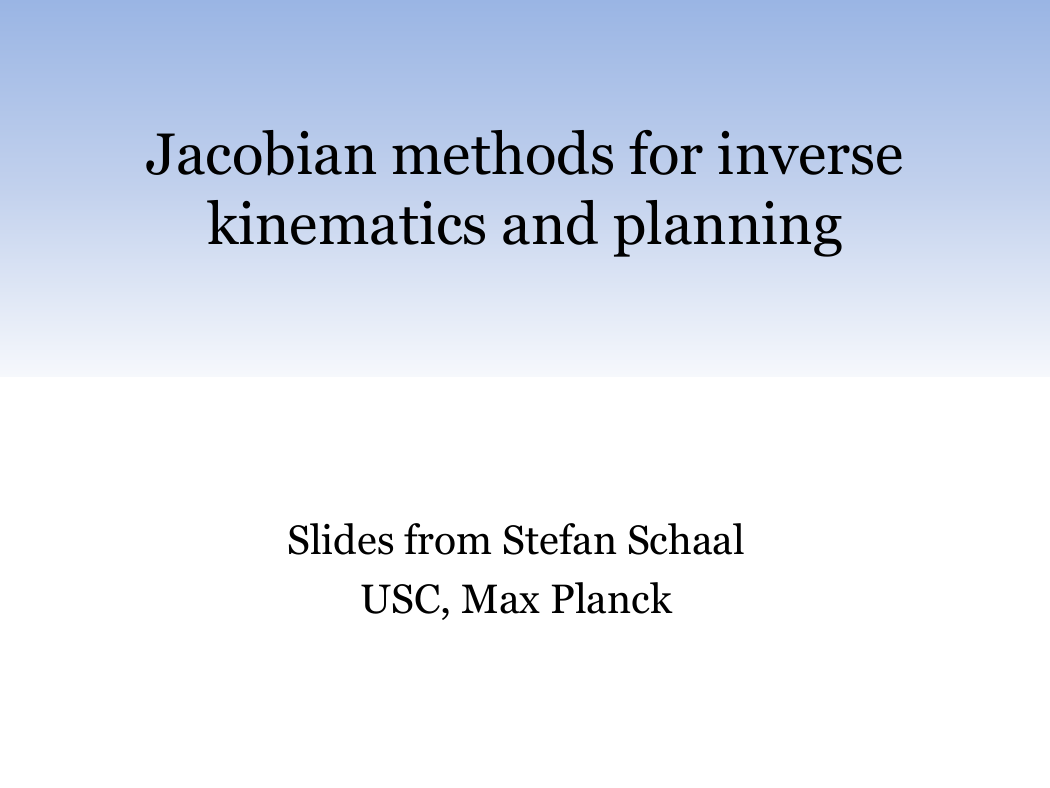


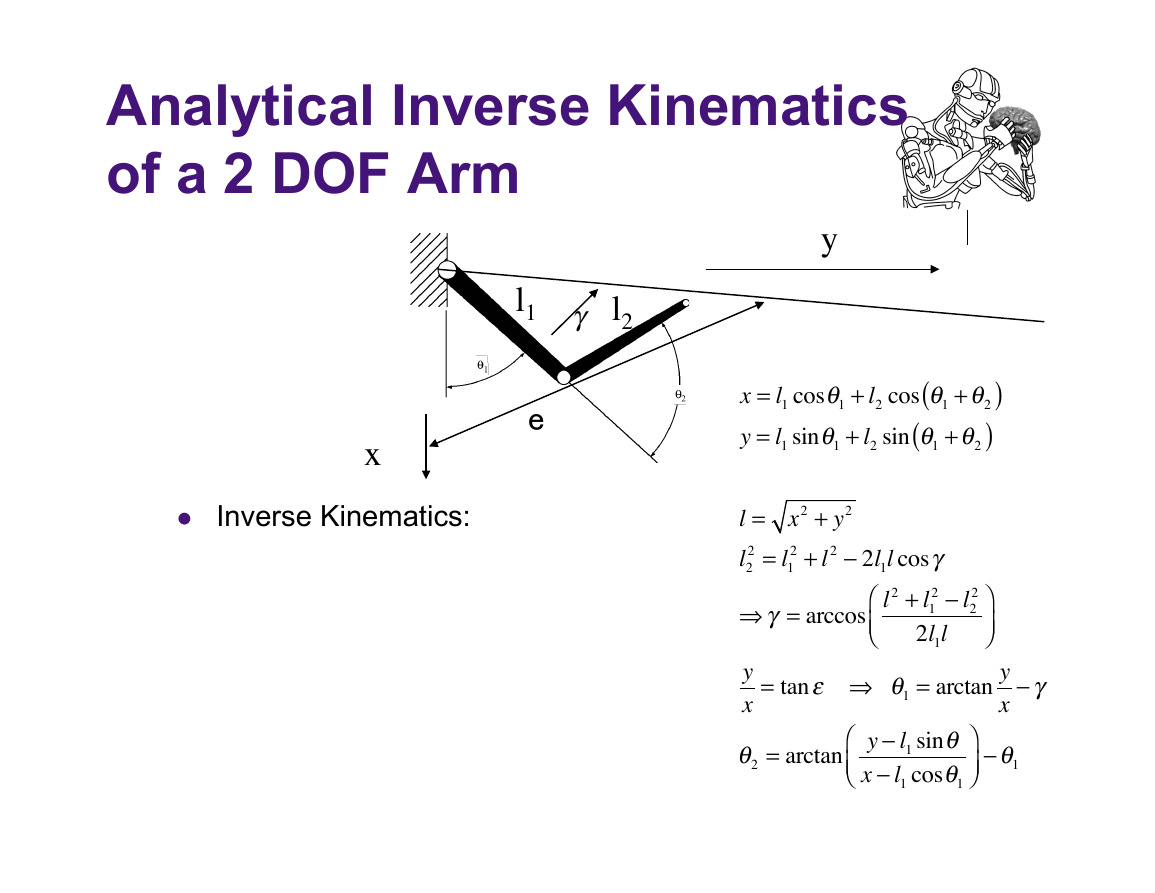
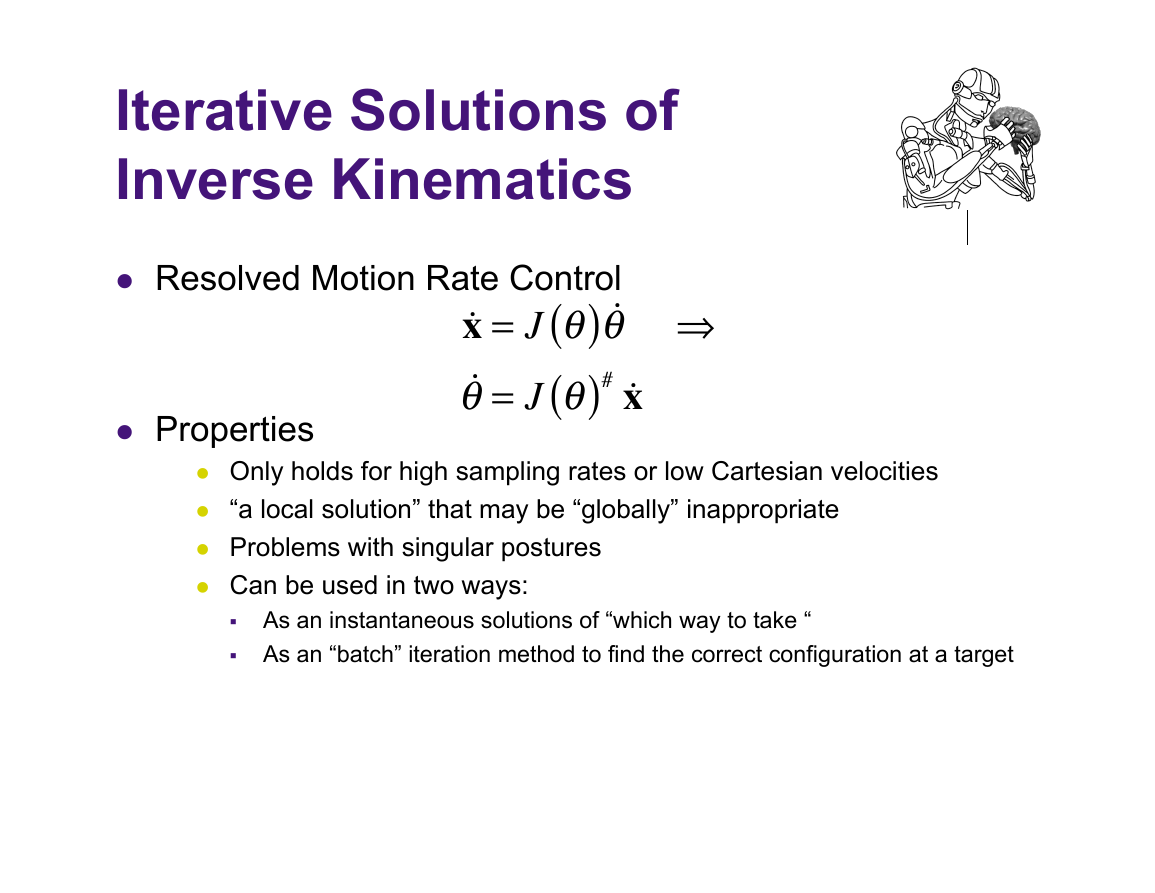
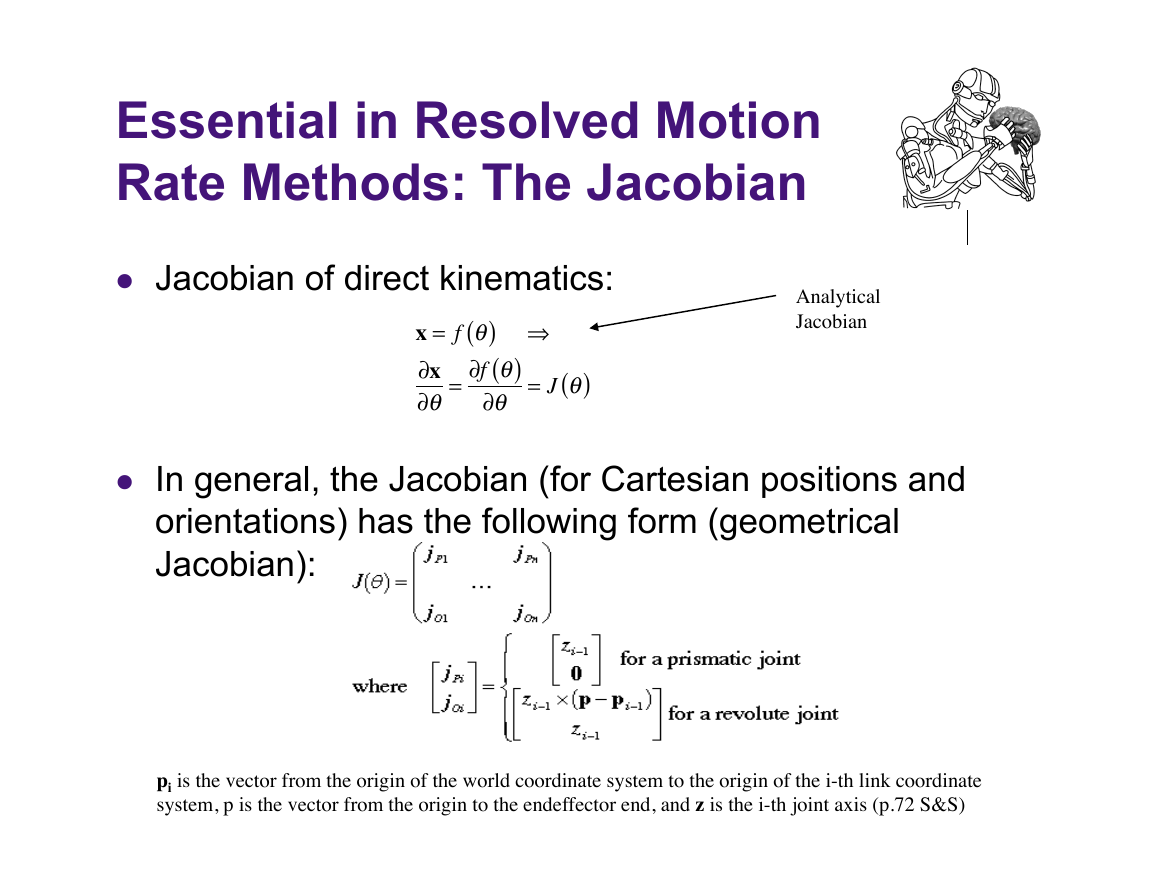
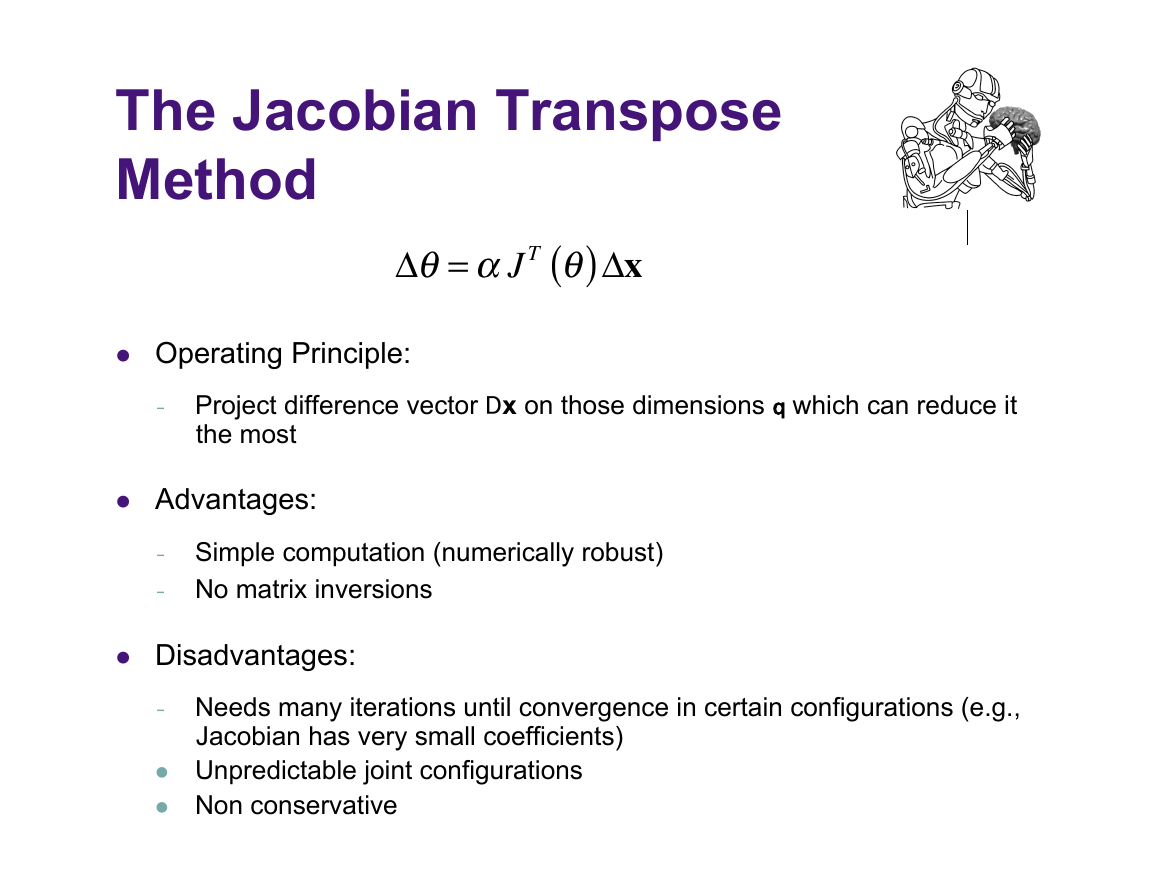
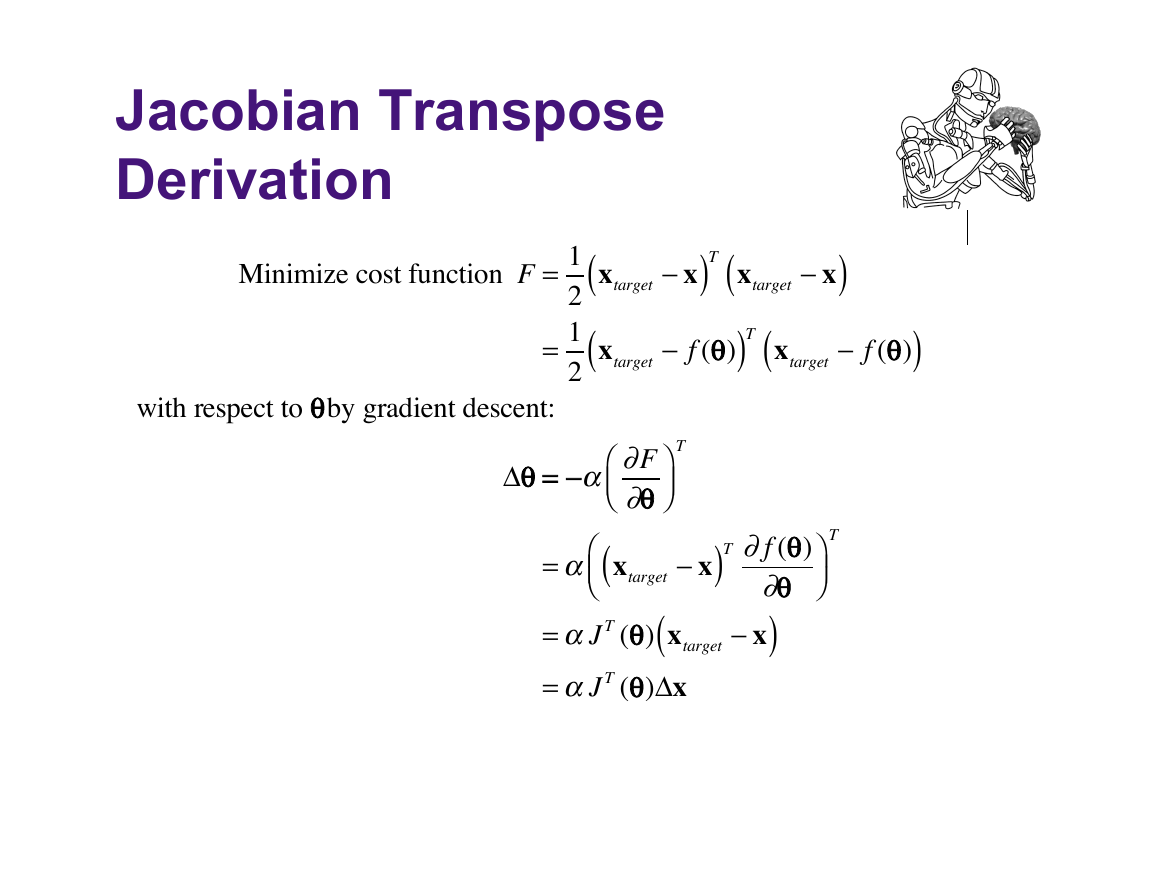








 2023年江西萍乡中考道德与法治真题及答案.doc
2023年江西萍乡中考道德与法治真题及答案.doc 2012年重庆南川中考生物真题及答案.doc
2012年重庆南川中考生物真题及答案.doc 2013年江西师范大学地理学综合及文艺理论基础考研真题.doc
2013年江西师范大学地理学综合及文艺理论基础考研真题.doc 2020年四川甘孜小升初语文真题及答案I卷.doc
2020年四川甘孜小升初语文真题及答案I卷.doc 2020年注册岩土工程师专业基础考试真题及答案.doc
2020年注册岩土工程师专业基础考试真题及答案.doc 2023-2024学年福建省厦门市九年级上学期数学月考试题及答案.doc
2023-2024学年福建省厦门市九年级上学期数学月考试题及答案.doc 2021-2022学年辽宁省沈阳市大东区九年级上学期语文期末试题及答案.doc
2021-2022学年辽宁省沈阳市大东区九年级上学期语文期末试题及答案.doc 2022-2023学年北京东城区初三第一学期物理期末试卷及答案.doc
2022-2023学年北京东城区初三第一学期物理期末试卷及答案.doc 2018上半年江西教师资格初中地理学科知识与教学能力真题及答案.doc
2018上半年江西教师资格初中地理学科知识与教学能力真题及答案.doc 2012年河北国家公务员申论考试真题及答案-省级.doc
2012年河北国家公务员申论考试真题及答案-省级.doc 2020-2021学年江苏省扬州市江都区邵樊片九年级上学期数学第一次质量检测试题及答案.doc
2020-2021学年江苏省扬州市江都区邵樊片九年级上学期数学第一次质量检测试题及答案.doc 2022下半年黑龙江教师资格证中学综合素质真题及答案.doc
2022下半年黑龙江教师资格证中学综合素质真题及答案.doc